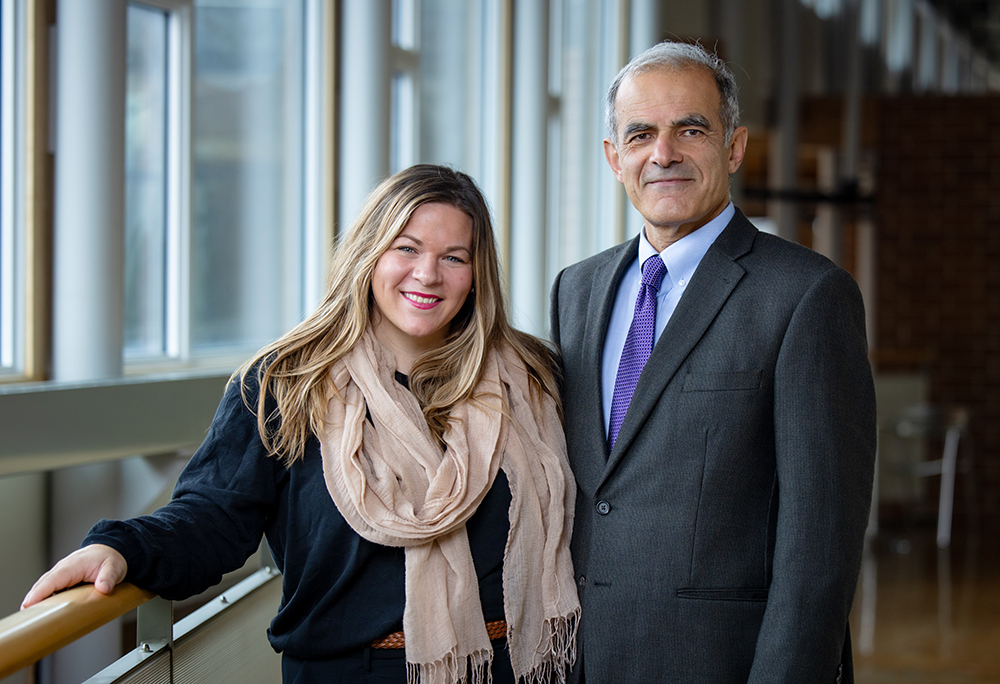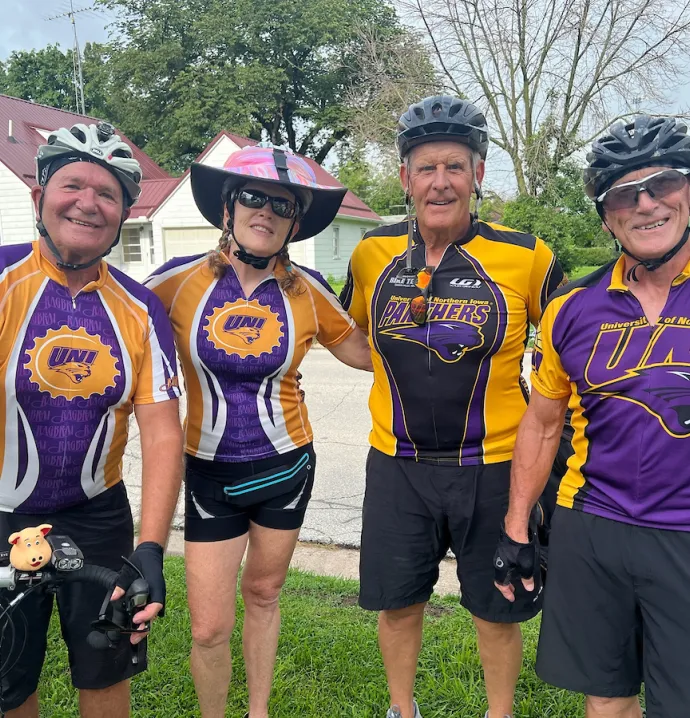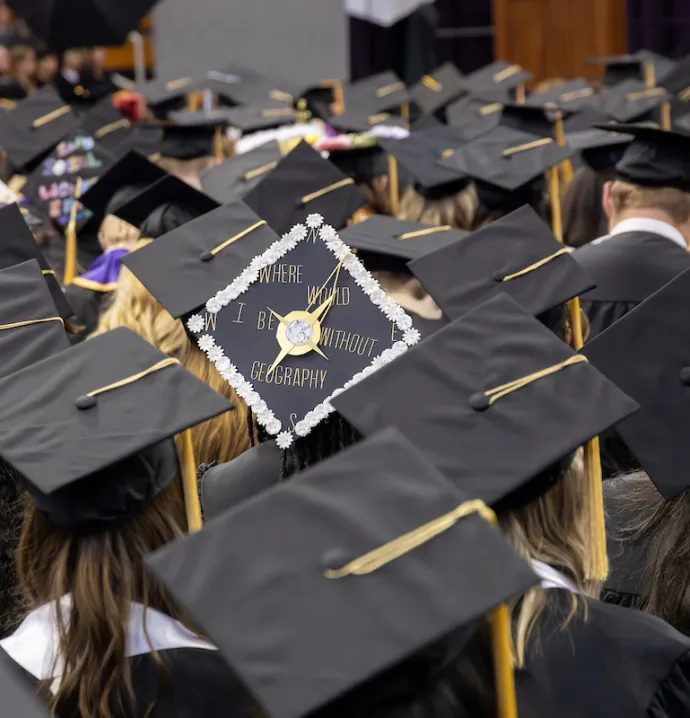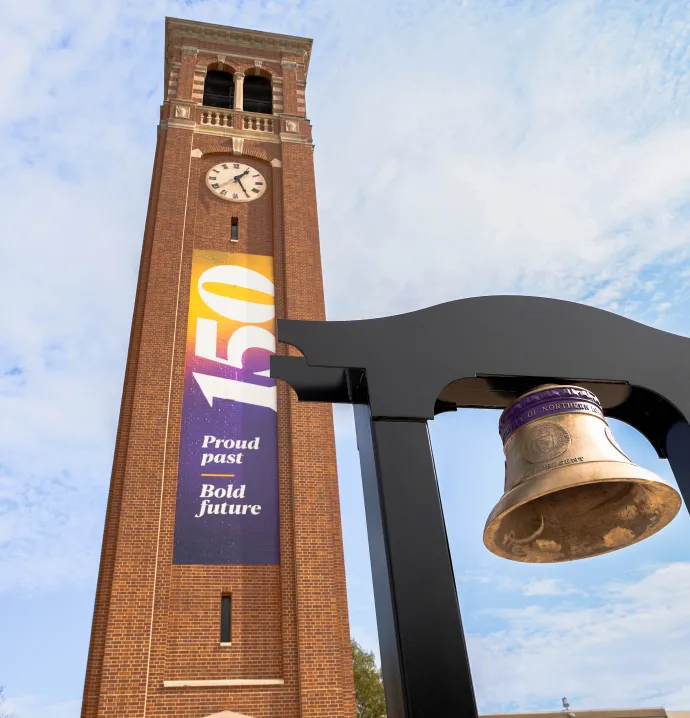Science into action
Science into action
Longtime Center for Energy & Environmental Education Director Passes Torch to New Leadership
While a student at Ohio State University in the late 1980s, Kamyar Enshayan studied mechanical engineering with an eye toward renewable energy. But as he progressed into his graduate studies, prospects seemed limited.
“At that time, in solar energy and renewable energy, there were not a lot of engineering jobs,” Enshayan recalled with a laugh, alluding to a sector that had yet to see significant investment.
Collaborating with fellow PhD students in the College of Agriculture set Enshayan on a new course. His horizons broadened beyond the confines of the engineering lab to the outside world and the intersection of ecology, natural science and food systems. A young Enshayan encountered the ideas of celebrated conservationist and Iowa native Aldo Leopold, whose “land ethic” called for greater harmony between people and the natural world and inspired the modern conservation movement of the 1960s. Decades later, it seemed all the more relevant.
And so study merged with action. Enshayan dropped what he was doing and spent his final summer as a student in rural Maine on a vegetable farm, learning to grow produce from plant starts, meticulously harvesting asparagus by hand, and dealing with the exigencies and day-to-day management of an organic farm.
A few years later, he would bring his newfound appreciation for sustainable food systems to Iowa.
“I had been so focused on machines and mechanics, and the natural world just didn’t exist,” Enshayan explained. “But that summer was my transformational moment, going from an engineer to somebody who now had an insight into a food system at the community scale.”
Fast forward to 2024. Some 40 years after picking up “A Sand County Almanac,” Enshayan closes the book on a distinguished career at the University of Northern Iowa. December marked his retirement after 31 years, the last 16 spent directing the university’s Center for Energy & Environmental Education (CEEE).

At UNI, Enshayan pursued environmental education and change at the local and state level with what his colleagues described as a “relentless” and “infectious” optimism. On any given day over the past three decades, one might find him speaking at a national conference, teaching students on campus or with his hands in the dirt, helping a community member experience the joys of gardening for the first time.
“Over all of these years, we’ve been a center that has totally focused on turning what we know into action,” Enshayan said. “We’ve developed the culture and the reputation that if you really want to do something, you come here.”
Enshayan passes the torch to new leadership poised to expand the CEEE’s high-impact work across environmental health, local food, energy conservation and climate resilience. Ashley Coffin, ’15, has been with the center since 2010 and stepped into the director role in January.
Coffin says the next chapter of the CEEE begins with “shoring up” their resources and building capacity to better serve Iowa while educating the next generation at UNI.
“Our center is operating better than it ever has,” Coffin said. “We have a lot of veteran staff. Our programs are well-established. We’re positioned to really be a leader within the state.”
Over all of these years, we’ve been a center that has totally focused on turning what we know into action. We’ve developed the culture and the reputation that if you really want to do something, you come here.
30 years of a sustainability hub
Environmental education is perhaps an underappreciated throughline in UNI’s history. According to the Rod Library Archives, the presence of “nature study” in the curriculum can be found as early as 1895. In 1915, the Iowa State Teachers College offered one of the earliest collegiate-level conservation courses in the nation.
Today’s CEEE began with the construction of the center along the south edge of campus. Boasting an environmentally conscious design, the CEEE building was dedicated in 1994, and programs were launched with an initial focus on K-12 education and energy conservation. Founding director William Stigliani articulated the CEEE’s role “to be the bridge between fact and public fiction … to promote what is certain and to find what is uncertain.”
The CEEE has continuously adapted in response to the needs of Iowa. A turning point came with the 2008 floods that devastated parts of Iowa. That year, Enshayan took over the center’s leadership, and Green Iowa AmeriCorps was created to assist with flood recovery efforts. In 2010, Coffin joined the CEEE to direct Green Iowa AmeriCorps.
A chapter of the national AmeriCorps (essentially a domestic Peace Corps), Green Iowa AmeriCorps has grown from two to 22 host sites, serving more than a dozen communities across much of the state. Their work spans in-home energy audits, collaboration with local governments on climate policy, and partnerships with schools, nonprofits, and communities on conservation and energy projects. According to Coffin, Green Iowa has completed more than 6,000 service projects alongside more than 400 community organizations and 27,000 volunteers.
Engaging students, improving communities
Across three decades, students have been at the heart of the CEEE’s work.
The student-led Good Neighbor Iowa program is one such example, drawing on environmental health research to reduce urban pesticide use and encourage safer lawn care practices. Since 2017, more than 2,000 Iowans (including parks, school districts and other organizations) have taken the Good Neighbor pledge, resulting in an estimated 12,000 mowed acres managed without pesticides and 20,000 children protected from unnecessary pesticide exposure.
Sarah Green, ’16, credits one of Enshayan’s courses and subsequent experiences at the CEEE while at UNI with sparking her interest in the environment. In 2024, she became executive director at the Iowa Environmental Council, a nonpartisan organization that for 30 years has been the state’s largest environmental coalition.
“The UNI CEEE shaped my life by inspiring me to lead with sustainability, critically think about environmental challenges, and encouraged me to create meaningful change in my community,” Green said. “I am sure that I am one of many students who Kamyar and the CEEE have inspired to see the power of education not just as a path to personal success, but as a vehicle for building a healthier, more equitable world.”

Legacy and looking ahead
In “A Sand County Almanac,” Leopold writes that, “One of the penalties of an ecological education is that one lives alone in a world of wounds.” Three decades of the CEEE cuts against that assertion — not by discounting or ignoring the gravity of environmental harms, but by focusing on what can be done, together.
“If there is one idea that has been shaping my passion and my line of work, it’s this idea of ‘the home region,’ and becoming competent and confident in the way we engage in the very communities of our region to improve it,” Enshayan said. “To not be disappointed, but to say, look, we have work to do.”
Enshayan points to one of the final initiatives he worked on at the center. Funded by the W.K. Kellogg Foundation, “Setting the Table for All Iowans” convened a broad coalition of state organizations to build consensus on steps to improve Iowa’s food systems. Their work is being implemented this year.
Coffin says the next chapter of the center will build on Enshayan’s example to continue to adapt and focus on change at the local level.
“What I’ve learned from Kamyar’s leadership is really how to lead with kindness and collaboration — and to really focus on making a difference in the community around you,” Coffin said. “Because at the heart of it all, where we live, in our local communities, is what makes up our life experience more than anything else.”
Programs
Initially offering a handful of programs in K-12 education and energy conservation, today the CEEE’s initiatives include nationally recognized programs:
- Environmental health
- Local food systems
- Green Iowa AmeriCorps
- Resilient Iowa communities




